The PDC is aware of an issue that is causing data on its website to load slowly. We have alerted the state’s Open Data vendor and are urging it to find the root cause. In the meantime, trying hitting the refresh button, or wait a few moments before trying your data query again.
Today, the Public Disclosure Commission launched its new lobbyist monthly report (L-2) filing system.
The new reporting system replaces the previous system. Lobbyists using the new system will notice some changes in how they complete the report. These changes were made based on feedback from lobbyists and the public, and are intended to improve usability of the system and ensure meaningful disclosure for the public.
Tip for filers: If you use the new system to amend a report originally filed in the previous system, the amendment will carry forward the previously entered compensation, personal expenses and entertainment expenses. All other expenses will have to be re-entered due to structural changes in the way the report is laid out in the new system.
The Oct. 30 launch will not change how lobbyists submit and update their registrations, nor will it impact how lobbyist employers complete annual L-3s. Changes to those parts of the registration and reporting process are coming later.
Instructions
Lobbyists and lobbying firms file monthly reports about their activity, also known as the L-2 report. Lobbyists begin filing after they have registered as a lobbyist, or after a lobbyist firm has entered into an employment contract with a client.
To file an L-2 report, first log into the Public Disclosure Commission’s lobbyist filing system. The lobbyist or lobbying firm that you file for should be listed under “Lobbyists I file for.” Select an entry. If the registered lobbying firm isn’t listed there, use the “Link Account to Existing Registration” function to request access to file for that lobbyist or firm. The PDC may need to review and approve this access prior to you being allowed to file reports.
The L-2 reporting window lists the L-2 reports for the months that the firm will lobby for their clients, as indicated in the employment contracts. Reports that haven’t been started yet have a “Start” button next to them – click that to begin filling out your monthly report. Forms in the system that are drafts have an “Edit” button, and the “Status” column to the right of the button says “Started.” Completed reports have a report ID number and the status column says “Filed.”
- You may copy information from a previously filed L-2
-
If your compensation, personal expenses or sub-lobbyist compensation have not changed from the previous month, you may copy information from a previously filed L-2.
If you click “yes,” select the previous L-2 report that you wish to copy from, and whether you want to copy the compensation, personal expenses, or sub-lobbyist compensation. You may pick one, two, or all three.
If you import information from a previous L-2, inspect that section to make sure that the information is accurate for the month that you’re reporting for.
Image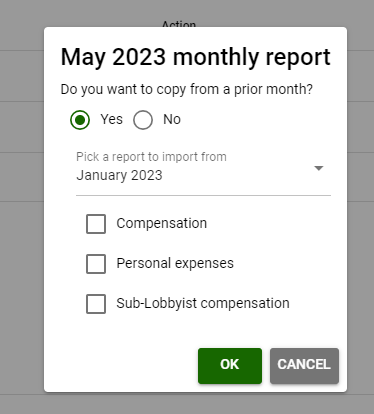
Completing the report
The lobbyist report has seven sections. In each section, you’ll need to answer “yes” or “no” questions to use the “Next” button to move on. If you want to jump ahead to a different section before answering the questions on the current screen, use the right-hand menu. The “finish later” function on the bottom right will save a draft of the report.
- 1. Compensation
-
A lobbyist should report all compensation for lobbying on the monthly L-2 report for the month when the lobbying took place. If a lobbyist is paid for lobbying in March, the compensation should be reported on the March L-2, even if the lobbyist is actually paid months later. Choose the source of funds from the drop-down list—the options will include all of the clients
If the lobbyist has more than one client, use the plus sign to open a window to enter compensation from each.
Image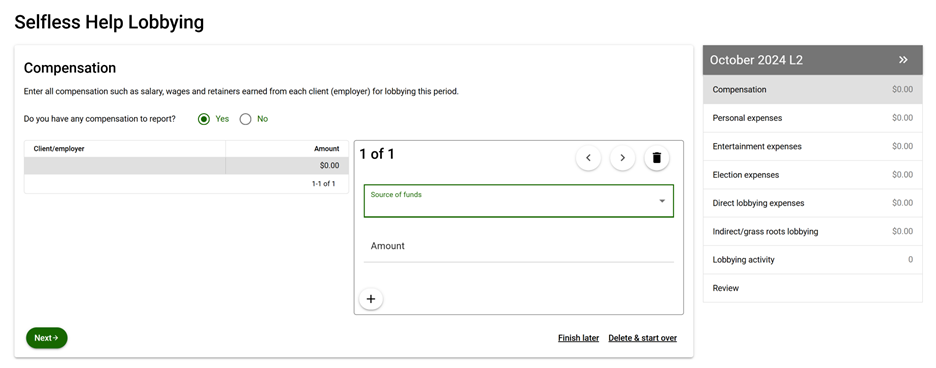
- 2. Personal expenses
-
Use the yes or no function to indicate whether there are any personal expenses to report. If the personal expenses were paid by a client, pick the client from the pop-up list under “source of funds.”
Image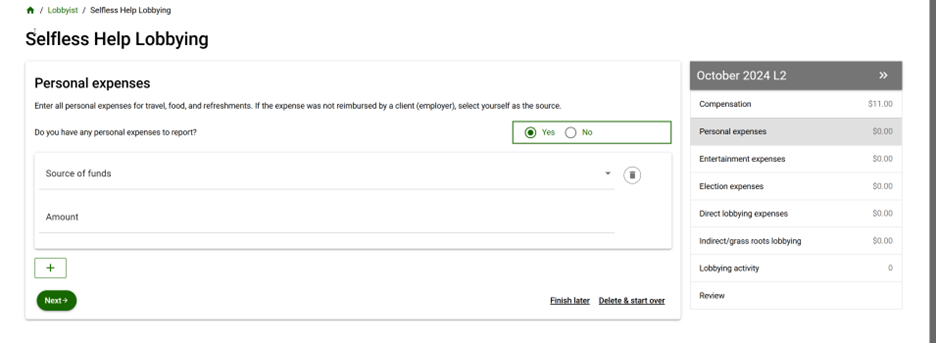
- 3. Entertainment expenses
-
Entertainment expenses of $100 or less may be entered as non-itemized expenditures — add all such expenses for the month together and enter them as a lump sum. If you have an individual entertainment expense of more than $100, click “yes” next to “Do you have any itemized entertainment expenses to report?” Tthen click “next.”
Fill out the form to describe the entertainment expense. If you have a second entertainment expense of more than $100 for that month, click the plus sign to add an second itemized entertainment expense.
Image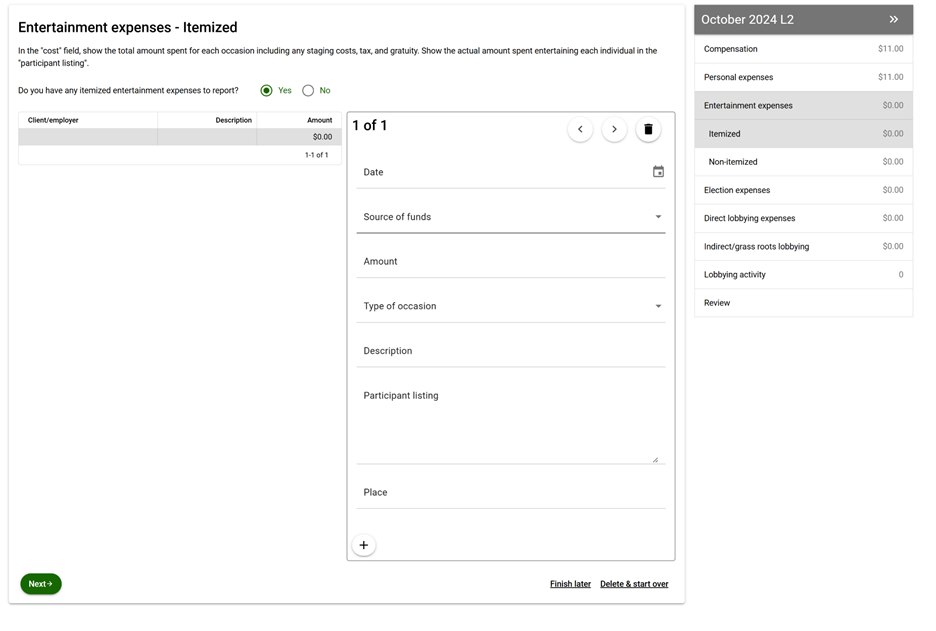
- 4. Election expenses
-
Answer all of the yes or no questions. If they are all “no,” you may click the link at bottom for “none of these apply.” For each question that you answer “yes,” the form will prompt you to enter details.
Image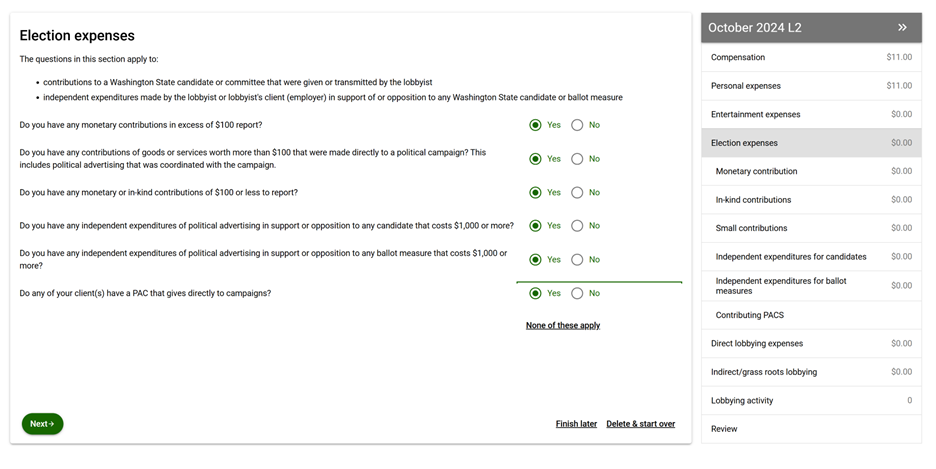
- 5. Direct lobbying
-
Answer “yes” or “no” to all five questions. If the answer to all questions is “no,” you may click the “none of these apply” link below.
- 6. Grassroots lobbying
-
Did the lobbyist or the lobbyist’s client receive contributions specifically for grassroots lobbying (advertising to the public about legislation) or indirect lobbying? If your answer is “yes,” the form will prompt you to file a grassroots lobbying report, or L-6.
If you say “no,” a second question asks if you have any expenditures by the lobbyist or the client for grass roots lobbying to report. Answer “yes” and report the expenditures if you do, or “no” if there are no such expenditures to report.
Image
- 7. Lobbying activity
-
Click “yes” here if the lobbyist has lobbied on a bill or rule during the month the report covers. Select a client under “source of funds,” then fill out the form. Use the plus sign to add more lobbying activities, if necessary.
Image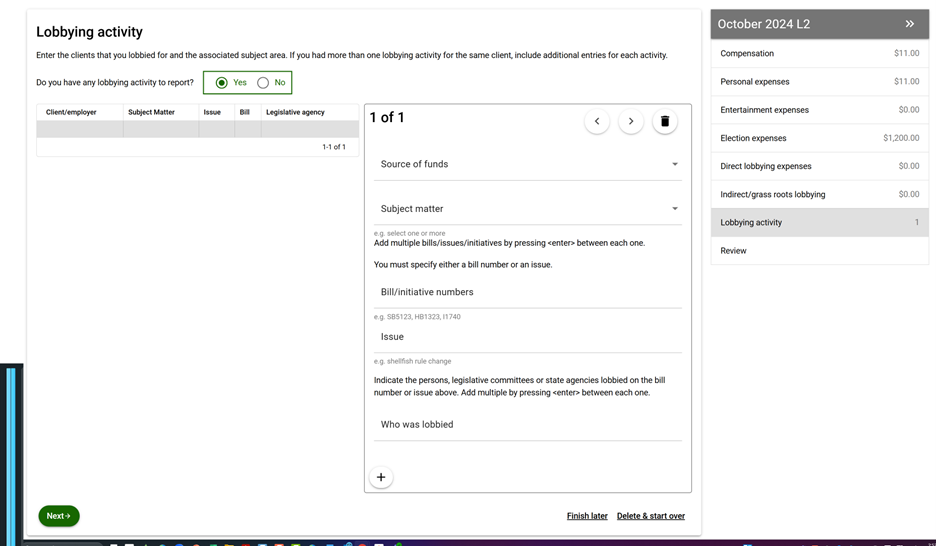
- Review your work and certify
-
At the review stage the system will check to see if you left a yes or no question blank anywhere on the form, or, for a question for which you answered “yes,” whether you omitted any information that should be entered. If you didn’t omit any required information, it will say “We have found no problems with your report.”
Click the “Preview and Submit button,” to view the entire L-2 report. Inspect it and make sure it is accurate for the month. If it is, click the “Submit” button at the top left.
To certify that the report is accurate and complete, type the words I CERTIFY in upper or lower case where it says “type here.” Click the “submit” button.